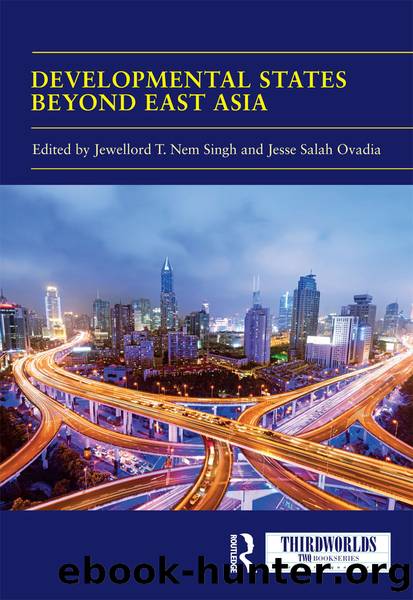Developmental States Beyond East Asia by Jewellord T Nem Singh & Jesse Salah Ovadia

Author:Jewellord T Nem Singh & Jesse Salah Ovadia [Singh, Jewellord T Nem & Ovadia, Jesse Salah]
Language: eng
Format: epub
ISBN: 9780367151980
Google: aga4vQEACAAJ
Goodreads: 42728903
Publisher: Routledge
Published: 2019-06-04T00:00:00+00:00
In this context, our paper takes a step back to assess what state capitalism entails from a sectoral perspective. In evaluating Brazilâs developmental state model and its effectiveness in managing economic globalisation, we focus on the PT governmentâs attempts at crafting sectoral linkages and reviving the capital goods industries through the oil and gas (O&G) sector â a strategy reflective of some familiar instruments characterising the state-led high growth regimes of East Asia. It is undoubtedly the case that Brazilâs model of development centred on state intervention, achieving key features of Northeast Asian developmental states. However, in contrast to Northeast Asia, Brazil lacked the coherence and social cohesion found in classic developmental states and failed to promote an overall re-orientation of the economy towards high value-added manufacturing.2 For these reasons, Schneider suggests that Brazilâs economic performance as a developmental state is medium, at best, since the countryâs political elites are coherent in terms of ideology and political intent (or developmental role) as well as capacity to direct policies (or developmental structures), leading to several successes in creating competitive sectors, such as in aerospace and O&G. However, the state falls short in terms of sustaining industrial growth and in creating innovation systems.3
Our substantive contribution to this special issue rests on advancing a critical appraisal of the successes and shortcomings of Brazilâs sectoral policies as a means to promote industrial growth. Our argument is as follows. Firstly, we claim that developmental states are motivated by political as opposed to economic rationale in pursuit of state-guided high growth regimes. Hence, the unravelling of Brazilâs developmental strategy is partly a consequence of how state-owned enterprises (SOEs) are intrinsically embedded in political interventions by national elites, leading to constrained choices over an SOEâs ability to make productive investments that would lead to innovation and competitiveness in the economy. Secondly, by focussing on the O&G sector as a case study, our paper argues that developmental states can design resource-intensive development strategies provided that a clear vision exists as regards how the national government will meet the high capital requirements and intensive technological innovation systems necessary to push for structural transformation through natural resources. Historically, the O&G industry is subject to heavy state regulation and characterised by state ownership through public enterprises. In Brazil, Petrobras played a central role in sectoral development and, through its particular relationship with the government, grew to become a major global energy player. Hence, the O&G sector is today one of the main drivers of the Brazilian economy; its contribution to national GDP increased substantially from 3% in 2000 to 13% in 2014.4 Echoing Ovadia and Wolf in this volume, scholars need to look beyond traditional sectors if we are to seek for emerging developmental strategies outside of the East Asian region. Brazil is an exemplar of a developmental state that has successfully industrialised in the recent past, but is also attempting to make important strides to seek new comparative advantages and promote alternative ways of doing industrial policy. Our paper, then, offers an initial evaluation as regards the gains and shortcomings of its strategy.
Download
This site does not store any files on its server. We only index and link to content provided by other sites. Please contact the content providers to delete copyright contents if any and email us, we'll remove relevant links or contents immediately.
What's Done in Darkness by Kayla Perrin(26800)
The Ultimate Python Exercise Book: 700 Practical Exercises for Beginners with Quiz Questions by Copy(20663)
De Souza H. Master the Age of Artificial Intelligences. The Basic Guide...2024 by Unknown(20442)
D:\Jan\FTP\HOL\Work\Alien Breed - Tower Assault CD32 Alien Breed II - The Horror Continues Manual 1.jpg by PDFCreator(20439)
The Fifty Shades Trilogy & Grey by E L James(19300)
Shot Through the Heart: DI Grace Fisher 2 by Isabelle Grey(19258)
Shot Through the Heart by Mercy Celeste(19124)
Wolf & Parchment: New Theory Spice & Wolf, Vol. 10 by Isuna Hasekura and Jyuu Ayakura(17291)
Python GUI Applications using PyQt5 : The hands-on guide to build apps with Python by Verdugo Leire(17225)
Peren F. Statistics for Business and Economics...Essential Formulas 3ed 2025 by Unknown(17070)
Wolf & Parchment: New Theory Spice & Wolf, Vol. 03 by Isuna Hasekura and Jyuu Ayakura & Jyuu Ayakura(16995)
Wolf & Parchment: New Theory Spice & Wolf, Vol. 01 by Isuna Hasekura and Jyuu Ayakura & Jyuu Ayakura(16611)
The Subtle Art of Not Giving a F*ck by Mark Manson(14608)
The 3rd Cycle of the Betrayed Series Collection: Extremely Controversial Historical Thrillers (Betrayed Series Boxed set) by McCray Carolyn(14305)
Stepbrother Stories 2 - 21 Taboo Story Collection (Brother Sister Stepbrother Stepsister Taboo Pseudo Incest Family Virgin Creampie Pregnant Forced Pregnancy Breeding) by Roxi Harding(13964)
Scorched Earth by Nick Kyme(12960)
Drei Generationen auf dem Jakobsweg by Stein Pia(11142)
Suna by Ziefle Pia(11065)
Scythe by Neal Shusterman(10552)
